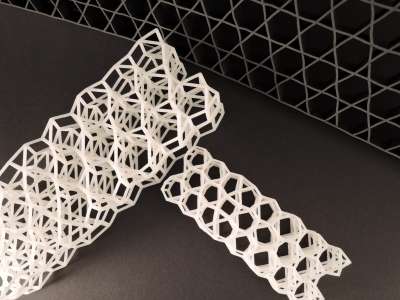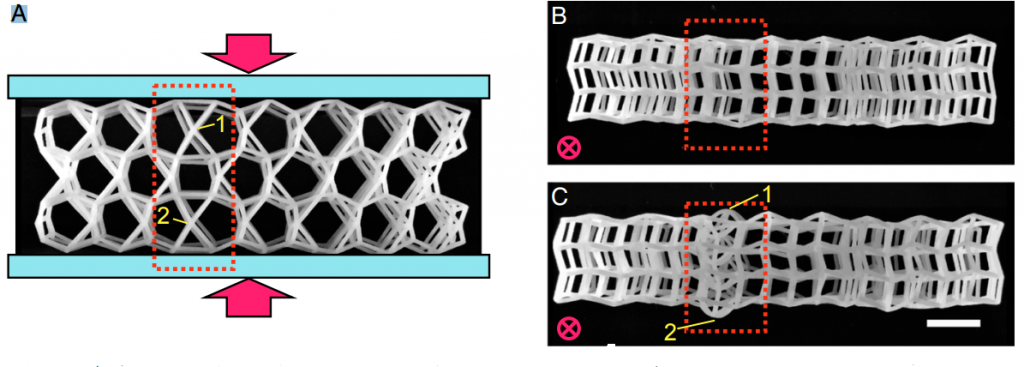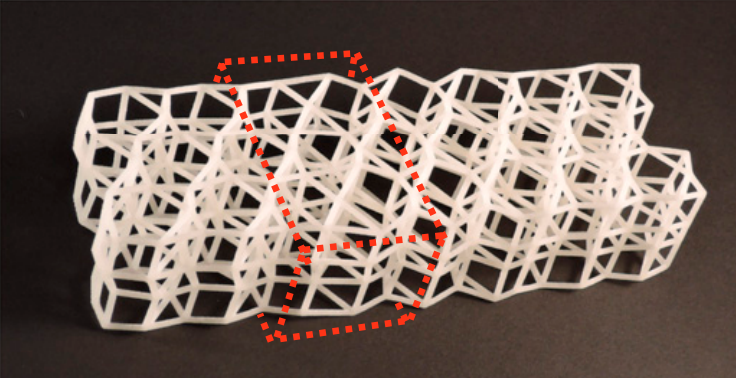Researchers Develop 3D Printed Lattices to Manipulate Buckling in New Mechanical Material
 As most are well-aware by now, 3D printing can be used to make many items that are fun, and even whimsical, from 3D printed parts for train sets to integrating the technology with virtual reality fun.
As most are well-aware by now, 3D printing can be used to make many items that are fun, and even whimsical, from 3D printed parts for train sets to integrating the technology with virtual reality fun.
As with anything though, the party always has to come to an end (or, ahem, it should for most), and in life it’s very often time to get back to work. There too though, the technology of 3D printing often lends a strong and serious hand in the engineering, medical, and aerospace fields–as well as many more. Digital design can be used almost routinely these days to create structural items to be 3D printed, working to innovate in building and creating various devices and components.
In the Netherlands, researchers have been very busy at work in designing lattice-like 3D printed structures to test a new and unique mechanical material that can be manipulated at strategic points for possible use as an insulator for frames–as a start. Just published in the Proceedings of the National Academy of Sciences, the researchers produced their findings in ‘Selective Buckling via States of Self-stress in Topological Metamaterials‘ explaining how they are able to ‘sculpt’ areas with specific points that will buckle and could even be used perhaps to morph into another shape due to temperature, stress, or deviation of a system, in context to areas of infrastructure and construction like bridges or buildings.
 This 3D printed ‘metamaterial’ is another product demonstrating how 3D printing can promote self-sustainability–and in this case, for a structure that needs to transform with tension and compression to ease stress or avoid failure altogether. With the researchers’ new 3D printed materials and subsequent concept for future use, structures would have a built-in flexibility for ultimately maintaining strength and integrity due to outside influences–but you’d never know just by looking.
This 3D printed ‘metamaterial’ is another product demonstrating how 3D printing can promote self-sustainability–and in this case, for a structure that needs to transform with tension and compression to ease stress or avoid failure altogether. With the researchers’ new 3D printed materials and subsequent concept for future use, structures would have a built-in flexibility for ultimately maintaining strength and integrity due to outside influences–but you’d never know just by looking.
“The salient feature of these localized buckling regions is that they are indistinguishable from their surroundings as far as material parameters or connectivity of their constituent elements are concerned,” state researchers Jayson Paulose, Anne S. Meeussen, and Vincenzo Vitelli in their paper. “Furthermore, they are robust against a wide range of structural perturbations.”
The project was completed at Leiden University’s Topological Mechanics Lab, led by Vincenzo Vitelli.
“The design begins with a general idea, a physical ‘hunch’, based on this analogy,” explains co-author Paulose. “The major strength of using these topological ideas in metamaterials design is that a topological material is guaranteed to have interesting behavior at the boundaries.”
The theory and concept they came upon, bottom line, was that of a new state of matter referred to as ‘topological insulators’ which have unique properties that can be exploited in mechanical engineering and perhaps other sectors as well, like medicine. That led to testing with 3D printed materials to see how mechanical load would be affected.
‘We were expecting some trial and error before getting the design to work. But the first batch that we got back from the 3D printing firm worked right out of the box,” said Paulose.
 Researchers focused on mechanical load and how these 3D printed metamaterials, featuring captured buckling behavior, could be used to improve traditional and existing structures and devices.
Researchers focused on mechanical load and how these 3D printed metamaterials, featuring captured buckling behavior, could be used to improve traditional and existing structures and devices.
“Here, we connect the mechanics of a cellular metamaterial, a foamlike structure made out of slender flexible elements, to that of a frame—a simpler, idealized assembly of rigid beams connected by free hinges—with the same beam geometry,” said the researchers in their paper. “We exploit the linear response of a recently introduced class of periodic frames, inspired by topologically protected quantum materials, to induce a robust nonlinear buckling response in selected regions of two- and three-dimensional cellular metamaterials.”
“The phenomenon survives even when the patterns on either side of the domain wall are nearly identical, reflecting the robustness of the topological design,” state the researchers.

Figure 1
Using “robust states of self-stress” to design buckling regions in topological metamaterials composed of flexible beams rigidly connected to each other at junctions, the researchers employed 3D printing to make their point as well as study the evidence and look toward the future. They are able to use very simple and clear demonstrations of this (see Figure 1) which show how compression would potentially cause ‘beams’ to buckle in a beneficial way–again using their 3D models to point out that these areas are not visible to the naked eye or disruptive to the construct of a structure. Being able to use very specific areas for almost shape-shifting duties may literally and figuratively change the framework of numerous industries.
Do you think construction materials that can almost instinctively buckle or transform due to a deviation in tension or compression will eventually be in widespread use? What do you see as other uses for this, and is it an engineering design you have thought about as well? Discuss in the 3D Printed Lattices forum thread over at 3DPB.com.
Subscribe to Our Email Newsletter
Stay up-to-date on all the latest news from the 3D printing industry and receive information and offers from third party vendors.
Print Services
You May Also Like
New Business: Temporary, Migratory, & Modular 3D Printed Architecture
If we look at potentially emerging 3D printing businesses, then architecture has not been fully explored. Yes, there is a lot of house 3D printing going on worldwide. From deployable...
3D Printing News Briefs, April 19, 2025: Material Extrusion Standard, Metal Powder, & More
In today’s 3D Printing News Briefs, we’re covering a proposed standard for material extrusion, before moving on to business and metal powder. We’ll end with a commercial store’s robotic 3D...
Japan Unveils World’s First 3D Printed Train Station
Japan is now home to what we believe is the world’s first train station built with 3D printing technology. Located in Arida City, just south of Osaka, the new Hatsushima...
restor3d Raises $38M to Expand 3D Printed Orthopedic Implants
Backed by $38 million in new funding, restor3d is pushing ahead with the launch of four personalized implant lines, set to roll out in 2025 and 2026. This latest venture...

























